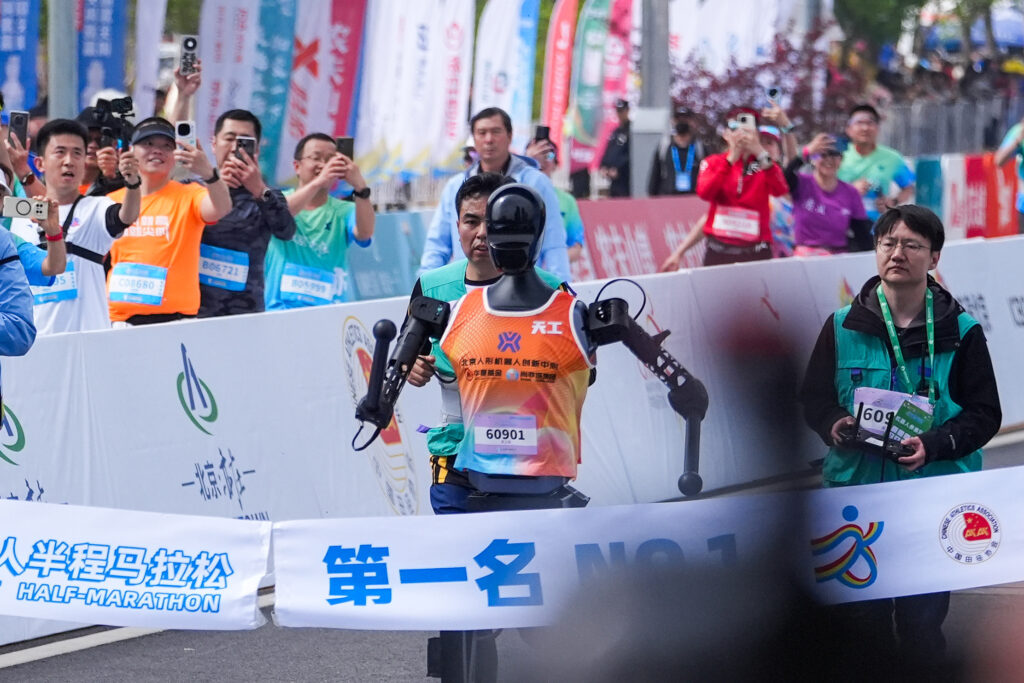A World’s First
An unprecedented event took place on April 19 in the suburbs of Beijing. A semi-marathon race was organized not only for humans—but also for humanoid robots. Out of the 21 robotic participants at the starting line, only four managed to complete the race. Tiangong Ultra was the fastest among them. It crossed the finish line more than an hour and a half after the winning human runner.
The Race Unfolds
Held in the Yizhuang technology district, the event drew approximately 12,000 human participants and 21 humanoid robots. The two groups ran on separate lanes for safety reasons.
The robots, developed by Chinese companies and institutions such as DroidUP, Noetix Robotics, and the Beijing Humanoid Robotics Innovation Center, were required to complete the 21.0975 km distance. Robots could be remote-controlled or semi-autonomous but had to walk or run on two legs. Indeed, heels or non-compliant mechanical assistance were prohibited. Battery replacement stations were allowed, though each swap incurred a 10-minute penalty.
Tiangong Ultra: The Robot Champion
Tiangong Ultra finished the race in 2 hours and 40 minutes. While significantly slower than the winning human (with a gap of 1 hour and 38 minutes), the robot performed well considering the challenge. For reference, the median time for human runners was 1 hour and 58 minutes.
Tiangong Ultra was developed by the Beijing Humanoid Robotics Innovation Center, backed by shareholders including Xiaomi and Ubtech. The robot stands 1.8 meters tall and weighs 53 kg. Other finishers included two bipedal « N2 » models from Noetix Robotics. One placed second, while the other came in fourth after penalties. Most of the robots were unable to keep up. “Little Giant” (75 cm tall) malfunctioned early, emitting smoke from its head, and “Shennong” fell, tripping one of its support technicians before crashing into the barrier separating the robot and human lanes.
Technological Showcase
Beyond the spectacle, the event served to highlight China’s rapid advances in humanoid robotics and to encourage further innovation. Awards were given not only for performance, but also for endurance, popularity, and design. This initiative aligns with China’s broader strategy to integrate humanoid robots into industry and public services by 2030.
A Strategic Opportunity for China
The race was a demonstration of China’s growing leadership in humanoid robotics—a critical sector in global technological competition. By showcasing robots capable of completing a half marathon, China sends a clear message: It is at the forefront of innovation.
The event also drew international media attention. By blending sports with cutting-edge tech, China bolstered its image as a modern, ambitious nation without resorting to coercive power.
Involving robots designed by Chinese institutions also reinforces domestic and international perceptions of China’s innovation capacity. It feeds into a sense of national pride—an essential component of soft power. Moreover, having robots race with humans rather than against them conveys a positive vision of shared progress. This message is likely to resonate with global audiences.
Therefore, China is crafting a vision of the future in which it plays a central, constructive role—much like Silicon Valley did in the early 2000s.
A Peaceful Technological Rivalry with the U.S.
China clearly aims to compete with the United States in the field of innovation. Companies like Huawei, Baidu, and DJI—and now Noetix and DroidUP in humanoid robotics—are positioning themselves as credible alternatives to U.S. tech giants.
The marathon serves as a “peaceful technological showcase,” demonstrating China’s capacity to produce advanced non-military technology with practical applications in industry, healthcare, and public services. It also serves as a counter-narrative to Western concerns about the potential « malicious » uses of Chinese technology, such as surveillance or cyber intrusion. It paints a picture of a creative, capable, and peaceful China—one that makes robots run, not weapons march. Viral images of robots falling or stumbling humanize the technology, generating media engagement and even humor.
Accelerating China’s Robotics Industry
The event provided unparalleled visibility for Chinese firms and research institutions involved in humanoid robotics. Companies like DroidUP, Noetix Robotics, and the Beijing Humanoid Robotics Innovation Center now enjoy increased recognition. This may stimulate both public and private investment. By proving the viability of robots in such a demanding scenario, China is paving the way for mass production across sectors such as security, logistics, healthcare, and customer service.
Boosting Exports and Global Influence
The international attention garnered by the event helps position China as a potential global supplier of humanoid robots. Countries dealing with aging populations—such as Japan or many European nations—may be particularly interested in medical or social assistance robots. Furthermore, by setting technical standards in robotics and embedded AI, China could gain technological influence, similar to its push with 5G.
Expanding Robotics-Based Services
Each humanoid robot acts as a gateway to a broader ecosystem of services, including AI modules, maintenance, software updates, sensors, and human-machine interfaces. Emerging business models like “Robot-as-a-Service” (RaaS) allow institutions to rent robots for specific tasks. This expands opportunities in both the service industry and event management.
Creating Jobs and Training Opportunities
As the sector grows, it will generate a wide range of skilled jobs—from hardware engineering and motion programming to AI ethics and autonomous systems cybersecurity. This evolution will require the development of specialized academic and vocational programs.
Tech-Driven Tourism and Public Engagement
This type of event has strong cultural and touristic appeal. By attracting media, investors, and tech enthusiasts from around the world, Beijing is building its brand as a global innovation hub. This could open the door to hosting international robotics conferences, expos, and competitions, with substantial economic benefits for the city and its surrounding tech districts like Zhongguancun and Yizhuang.










